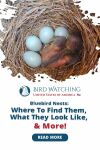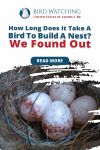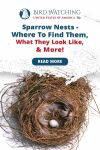
What’s this post about?
Bluebirds are lovely birds to observe with binoculars. The bluebird, with its different shades of blue, carries the same energy an open sky has. It is no less than refreshing to witness these birds.
Apart from being immensely beautiful, bluebirds are surprisingly energetic. You may get hours of enjoyment observing all the great work these little birds put into acquiring resources to make nests and collect food to feed their babies. However, to see this, you must know details about their nests’ appearance and where to find them.
You will be able to find bluebird nests in cavities made by other birds or decaying trees that naturally provide holes. They choose spots that are at a height and have a clear view of fields in front. The nests have a cup shape made with twigs and lined with animal fur and soft grass.

Where to find bluebird nests?
Bluebirds prefer vast areas with short grass. They like having an unobstructed flight route, especially overlooking a field. Orchards, mowed fields, extensive lawns, graveyards, sidewalks, and places with dispersed trees and low vegetation are all examples of this type of habitat.
Before you can discover the bluebird’s nest, you must first grasp the birds’ appearance. You have a better chance of spotting the bird than its nest. Once you’ve found the bird, it’ll only be a matter of time before it takes you to their nest.
These gorgeous North American birds have three species, all of them just as pretty. The eastern and western bluebirds are a combination of blue and red. They have a bright royal blue on the head and back and a rich red on the chest. On the other hand, the mountain bluebird is entirely pale blue.
Location
If you know nothing about bluebird habitat or live outside America, you should start with their generic location. Put them on a map before you go searching out for their preferred sites.
Your journey might be useless if you look for open grasslands in locations the birds don’t exist in. Here is how the three types of bluebirds are distributed in America:
- Eastern Bluebirds may be found throughout eastern North America and south till Nicaragua.
- Western bluebirds may be found in California, the southern Rocky Mountains, Arizona, and New Mexico.
- Mountain bluebirds may be observed over western North America.
What do bluebird nesting sites look like?

A species that nests solely or almost exclusively in natural or artificial cavities is known as a cavity nester.
Bluebirds are obligatory cavity nesters, meaning they only make nests within cavities, chambers, or structures that look like compartments. Bluebirds are incapable of making their nesting holes. They must rely on either natural decay or woodpeckers to construct a spot for them within the trees.
DID YOU KNOW?
77% of the time, bluebirds inhabit cavities created by woodpeckers while breeding in natural holes.
In any case, the bluebird will have to explore the area for a viable cavity in a safe setting as it has become increasingly difficult today due to the following reasons:
- Many trees that develop cavities have been cut down due to excessive development.
- Today’s landscaping techniques encourage removing aged or decaying trees instead of keeping them as an animal habitat.
- Rival species such as house sparrows and starlings have encroached on the few natural crevices that remain.
PRO-TIP
If you have a dying tree in your yard, do not remove it. These trees must not be cut down but instead allowed to die naturally. And the years-long process of decay offers food, protection, and nesting places for various species, particularly bluebirds.
The bluebird population has plummeted since many of these natural nesting places have been destroyed by urbanization. On the other hand, nesting boxes have served a critical part in the recovery of the beloved bluebird, and this is because to a bluebird, the nest box resembles a natural nesting hole.
When do bluebirds start building their nests?
Year-round inhabitants start building nests in February and March when migrant Bluebirds are only beginning to arrive in the northern states. Bluebirds begin constructing nests in Michigan and Minnesota between March and late April.
Like those in the mid-eastern and southern warmer states, bluebirds who remain in their territory throughout the year begin nesting sooner than those who move to the northern and colder parts of the bluebird’s spectrum.
Once a male Eastern Bluebird has lured the female to his nest location, the female conducts the nest-building process. The male bluebird attracts the female by bringing items in and out of the hole, roosting, and flapping his wings.
Bluebirds, who pair for life, do not divide all of the nesting responsibilities evenly. In around 5.5 days, the female constructs the home all by herself.
DID YOU KNOW?
According to some research, 30% of bluebirds go back to their original nesting locations the following season.
Nest Description

The female builds the nest by carefully stringing grasses and pine needles around it, creating a firm foundation on which to build. She might then line it with small grass, animal fur, and even turkey feathers.
The nest has the shape of a cup that is somewhat deep and frequently cylindrical, having a depth of approximately 3-4 inches, its cup section is 2.5 inches in diameter and around 2.25 inches deep.
When there are two chambers in an area, some birds make a nest in each one. However, only one of them is used to deliver the eggs and nurture the baby.
DID YOU KNOW?
Bluebirds will mostly choose to build their nest cups at the rear of the box, away from the entry hole.
What happens after nest building?

6 to 7 days after the nest is completed and 14 days after construction, the female bluebird begins delivering its eggs. In the warmer southern states, egg deposition occurs in February and March, starting in March and April in the northern and chilly areas.
Eastern bluebirds generally have two batches each year, although three batches are frequent in warmer areas. Mountain Bluebirds are observed to lay larger but lesser batches in the northern portion of their territory than Western or Eastern bluebirds. This means there will be more eggs in one batch, but the number of batches is less overall.
Bluebirds usually lay 4 to 5 eggs, although they can lay up to 7 eggs in certain circumstances. There are scarce instances where two females might end up spreading their eggs in one nest. In that case, the eggs are incubated and taken care of by both females.
DID YOU KNOW?
The female bluebird will lay one egg every day.
Bluebird eggs are usually blue in hue. They may be pale blue, powder blue, or blueish white. However, certain females may deposit white or pink eggs on rare occasions. Within a clutch, the egg color does not change. A female can lay entirely blue, entirely white, or even all pink eggs.
For how long do bluebirds incubate?
The time it takes for the Bluebirds to incubate their eggs varies depending on the temperature.
When the female delivers the last egg of the batch, they will start incubating the eggs for 13 days on average. A female may begin nursing the eggs a day before the final egg is deposited. Warmer locations have a shorter incubation period, whereas northern and more relaxed states have a lengthier one.
DID YOU KNOW?
Bluebirds do not incubate until the delivery of their last egg to ensure that all chicks hatch together.
The male bluebird generally has a minor role to play after attracting a female to its nest. The male does not take part in the egg incubation process. Its next task is to defend the area and feed the female while incubating and nurturing the eggs.
Naturally, the female will take a break from the incubation process. In the mornings and during the day, the female takes pauses to eat and defecate. Both the male and female scavenge around the nest during such intervals, keeping an eye out for intruders nearing the nest.
Will any eggs fail to hatch?

According to research on Bluebird nests, around 83 percent of eggs hatch as scheduled, while 17% of eggs never hatch. The mother bluebird will lay on her eggs for 13 to 14 days. If any of these eggs fail to hatch within 72 hours of the last chick’s emergence, it indicates that something is wrong.
What Happens to the Unhatched Eggs?
The unhatched eggs will either be unintentionally crushed by the new fledging or be pushed out by the parents once disclaimed as unviable. If the eggs are destroyed within the nest, the parents will make an effort to remove the shell pieces.
Sometimes none of the eggs hatch as per the expected time. In that case, the female bird will continue incubating them without realizing something is wrong with the entire batch. Once and if the female bluebird recognizes that all the eggs have been miscarried, the couple then begins a new mating effort by building a new nest on top of the unsuccessful brood.
Why Do Some Eggs Fail to Hatch?
There are several causes for this, but we don’t always know why an egg doesn’t hatch. Extreme temperatures, chemical exposure, genetic abnormalities, and bacterial infections are the most likely causes.
Another common reason why eggs fail to hatch is poor incubation which may happen due to several reasons like:
- Scarce food forcing the female to abandon its nest to find food
- Predatory attacks causing the female to desert or defend the territory
- The female was inexperienced
- The male bluebird was off fighting, or the female was widowed, so there was no one to feed the female.
WARNING!
Do not approach nests during the incubation period because it may distract either or both parents, resulting in poor incubation.
Can you find bluebird eggs in other nests?

Bluebird eggs were discovered in the homes of many other cavity-nesting species, including Carolina Wrens, Chickadees, and sometimes even House Sparrows' nest boxes.
You may find bluebird eggs in other nests in particular circumstances. If a bluebird’s nest gets destroyed amidst a predator attack, the female will search for an alternative location rather than losing a viable egg. When a female depends on another couple to rear her egg, it is called conspecific brood parasitism.
Even though this is rarer, it is also possible that other eggs may be found in bluebird nests. Brown-headed Cowbird is a bird that is very popular for depositing eggs into other nests. They do, however, require larger entrances to cavities.
This is a less than ideal situation. Unlike other species, the bluebird will not incubate the stranger egg with its brood. It is most likely that the female will abandon the eggs or build a nest on top of this clutch to start breeding again.
PRO-TIP
You can prevent other animals from depositing their eggs into bluebird nests by making their entrance smaller than 5.5cm.
Do bluebirds abandon their nests?
Male and female Bluebirds play distinct roles during the mating season, and losing one pair at different periods might lead to nest abandonment. Other reasons are that the eggs cannot be hatched, the eggs overheat, or if a predator attacks the nest or eggs.
Eggs Don’t Hatch
As previously discussed, bluebird eggs may not hatch for many reasons. The eggs may be infertile, may be infected with diseases, or the female may have gotten off them multiple times during incubation. When the eggs do not hatch at the correct time, the bluebirds will abandon that nest and restart on top of it.
Predators
Bluebirds may be forced to abandon their nests when they encounter a predator. Predators like cats enjoy reaching out for the adult birds themselves. They may cause the parents to flee the sight to save their own lives. Predators like snakes and raccoons, on the other hand, will consume the children.
Parents Go Missing
In the case one of the parents goes missing, the timing is critical. Both parents play separate roles during separate stages of breeding. Situations like the following can lead to an abandonment of the nest:
- Suppose the male disappears during the incubation period. The female needs a partner at that time to feed and defend the family. In the father’s absence, the female might have to play dual roles resulting in poor incubation.
- Suppose the female disappears during the incubation period. The male bluebird is incapable of incubating the eggs and might end up abandoning the brood.
- If either partner dies and the other finds a new mate. It is most likely that the new couple will want to start fresh and will desert the old batch of eggs.
There are certain situations where even if one of the parents goes missing, abandoning the nest is unnecessary. This again depends on timing. If the female disappears after the fledging are older, they might survive if the father continues feeding them.
Overheated eggs
During the summertime, warmth can be a problem in certain nest boxes and natural cavities. If the temperature in the nest box rises above 107°F, the eggs and nestlings will die. The bluebirds will recognize this and will either start over or relocate to a different nesting place.
WARNING!
Ensure that any nest box you build for bluebirds has proper ventilation. Lack of air or increased heat may result in the birds dying.
Keep Reading!
Since bluebirds choose to nest in crevices in exposed, sunny areas, humans can watch them more closely than most other species. Since natural cavities in clearings are uncommon, these birds easily employ nest boxes.
While the female does the labor of building the nest and incubating the eggs, the male stands alert to defend and provide food for the family.
Now that you know all about a bluebird’s nest, here’s a post about sparrow nests you can read to know where you can find them.
Sparrow Nests: Where To Find Them, What They Look Like & More
Get to know everything about sparrow nests in this post. Once you’ve read through, it shouldn’t be hard to spot one the next time you see it!

By David A. Swanson
Bird Watching USA
My name is David and I'm the the founder of Bird Watching USA! I started Bird Watching with My father-in-law many years ago, and I've become an addict to watching these beautiful creatures. I've learnt so much over about bird watching over the years that I want to share with the world everything I know about them!

David A. Swanson
Bird Watching USA
My name is David and I'm the the founder of Bird Watching USA! I started Bird Watching with My father-in-law many years ago, and I've become an addict to watching these beautiful creatures. I've learnt so much over about bird watching over the years that I want to share with the world everything I know about them!








